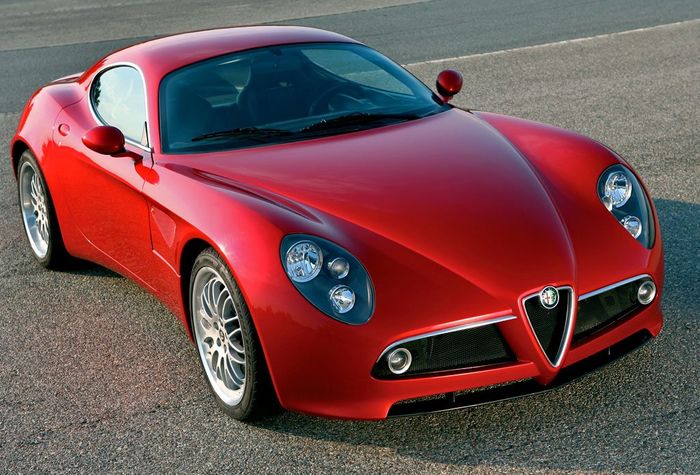Alfa Romeo 8C Red
The Alfa Romeo 8C name was used on road, race and sports cars of the 1930s. The 8C means 8 cylinders, and originally referred to a straight 8-cylinder engine. The Vittorio Jano designed 8C was Alfa Romeo's primary racing engine from its introduction in 1931 to its retirement in 1939. In addition to the two seater sports cars it was used in the world's first genuine single-seat Grand Prix racing car, the Monoposto 'Tipo B' - P3 from 1932 onwards. In its later development it powered such vehicles as the twin-engined 1935 6.3 litre Bimotore, the 1935 3.8 litre Monoposto 8C 35 Type C, and the Alfa Romeo 8C 2900B Mille Miglia Roadster. It also powered top of the range coach-built production models. In 2004 Alfa Romeo revived the 8C name for a V8-engined concept car which has made it into production for 2007, the Alfa Romeo 8C Competizione.
History
In 1924, Vittorio Jano created his first straight eight cylinder engine for Alfa Romeo, the 1987 cc P2, with common crankcase and four plated steel two cylinder blocks, which won the first World Championship ever in 1925. Albeit it was a straight-8, the 8C designation was not used.The 8C engine, first entered at the 1931 Mille Miglia road race through Italy, had a common crankcase, now with two alloy four cylinder blocks, which also incorporated the heads. The bore and stroke (and hence rods, pistons and the like), were the same as the 6C 1750 (bore: 65 mm, stroke: 88 mm). There was no separate head, and no head gasket to fail, but this made valve maintenance more difficult. A central gear tower drove the overhead camshafts, superchargers and ancillaries. As far as production cars are concerned, the 8C engine powered two models, the 8C 2300 (1931–1935) and the even more rare and expensive 8C2900 (1936–1941), bore increased to 68 mm and stroke to 100 mm.
At the same time, since racing cars were no longer required to carry a mechanic, Alfa Romeo built the first single seater race car. As a first attempt, the 1931 Monoposto Tipo A used a pair of 6 cylinder engines fitted side-by-side in the chassis. As the resulting car was too heavy and complex, Jano designed a more suitable and successful racer called Monoposto Tipo B (aka P3) for the 1932 Grand Prix season. The Tipo B proved itself the winning car of its era, winning straight from its first outing at the 1932 Italian Grand Prix, and was powered with an enlarged version of the 8C engine now at 2665 cc, fed through a pair of superchargers instead of a single one.
Initially, Alfa Romeo announced that the 8C was not to be sold to private owners, but by autumn 1931 Alfa sold it as a rolling chassis in Lungo (long) or Corto (short) form with prices starting at over £1000. The chassis were fitted with bodies from a selection of Italian coach-builders (Carrozzeria) such as Zagato, Carrozzeria Touring, Carrozzeria Castagna, Pininfarina and Brianza, even though Alfa Romeo did make bodies. Some chassis were clothed by coach-builders such as Graber, Worblaufen and Tuscher of Switzerland and Figoni of France. Alfa Romeo also had a practice of rebodying cars for clients, and some racing vehicles were sold rebodied as road vehicles. Some of the famous first owners include Baroness Maud Thyssen of the Thyssen family, the owner of the aircraft and now scooter company Piaggio Andrea Piaggio, Raymond Sommer and Tazio Nuvolari.
Models
1931 8C 2300
The first model was the 1931 '8C 2300', a reference to the car's 2.3 L (2336 cc) engine, initially designed as a racing car, but actually produced in 188 units also for road use. While the racing version of the 8C 2300 Spider, driven by Tazio Nuvolari won the 1931 and 1932 Targa Florio race in Sicily, the 1931 Italian Grand Prix victory at Monza gave the "Monza" name to the twin seater GP car, a shortened version of the Spider. The Alfa Romeo factory often added the name of events won to the name of a car.1931 8C 2300 Le Mans type
8C 2300 tipo Le Mans' was the sport version of the '8C 2300' and it had a successful debut in the 1931 Eireann Cup driven by Henry Birkin. It won the 24 Hours of Le Mans in 1931 (Howe-Birkin); 1932 (Chinetti-Sommer); 1933 (Nuvolari-Sommer) and 1934 (Chinetti-Etancelin).The 8C 2300 Le Mans model on display at the Museo Alfa Romeo was bought by Sir Henry Birkin in 1931 for competition use, but it is not the car in which Birkin and Howe won the 1931 Le Mans 24 hours.








Tidak ada komentar:
Posting Komentar